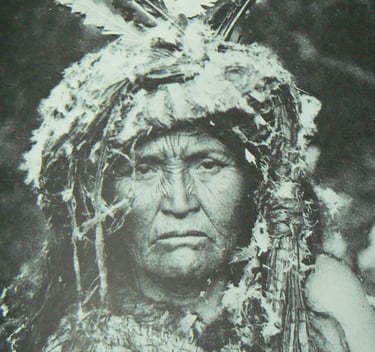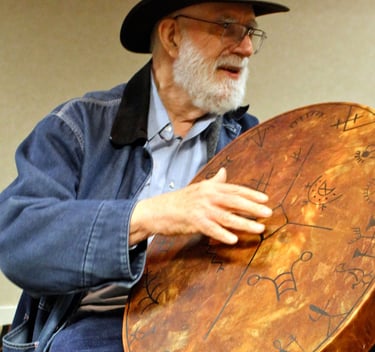
Shamanism: A Journey into Spiritual Healing
SURCH team
5 min read
The Role of the Shaman
A shaman healer is more than just a spiritual guide; they are considered to be individuals with the unique ability to communicate with the spirit world. These native american shaman healers and their counterparts in other cultures use various techniques to enter altered states of consciousness, allowing them to journey to spiritual realms and interact with spirits on behalf of their communities.
One of the most recognizable tools in a shaman's arsenal is the shaman drum. These drums play a crucial role in many shamanic practices, their rhythmic beats helping to induce trance-like states and facilitate spiritual journeys. The use of shaman drums, along with other techniques like chanting or the use of psychoactive substances, enables shamans to access different levels of reality and gather wisdom or healing energies.
Reasons for Seeking Shamanic Healing
People seek shamanic healing for a variety of physical, emotional, mental, and spiritual reasons. Some common motivations include:
Physical ailments: Individuals may turn to shamanic healing for chronic pain, illnesses that have not responded well to conventional treatments, or mysterious symptoms without clear medical explanations.
Mental health issues: Shamanic practices are sometimes sought for conditions like depression, anxiety, PTSD, and addiction. Shamans view these as spiritual imbalances rather than purely psychological disorders.
Emotional healing: People experiencing grief, trauma, or feeling emotionally stuck may seek shamanic healing to process and release these emotions.
Soul retrieval: A key concept in shamanism is soul loss, where parts of the soul are believed to fragment due to trauma. Soul retrieval ceremonies aim to bring back these lost soul parts, potentially addressing issues like chronic depression, apathy, or feeling incomplete.
Spiritual exploration: Some individuals are drawn to shamanic practices out of curiosity about spirituality or a desire to connect more deeply with nature and the spirit world.
Life transitions: During major life changes like career shifts, relocations, or relationship transitions, people may seek shamanic guidance for support and clarity.
Ancestral healing: Shamanic traditions often work with ancestral spirits, and some people seek healing for generational trauma or to resolve issues believed to be inherited from ancestors.
Energy imbalances: Shamans work with concepts of energy and may be consulted to remove energetic blockages or restore balance to a person's energy field.
Curse removal: In cultures where curses are believed to be real, shamanic practitioners may be sought to remove curses or negative energies.
Spiritual awakening: Individuals experiencing unexplained mystical or paranormal phenomena may turn to shamans for guidance and understanding.
It's important to note that while many people find value in shamanic healing, it should not be seen as a replacement for conventional medical care. Reputable shamanic practitioners often encourage clients to work in conjunction with medical professionals, viewing shamanic healing as complementary rather than alternative to modern medicine.
Concept of Soul Loss and Retrieval
A fundamental aspect of shamanic healing is the concept of soul loss and soul retrieval. In shamanic belief, traumatic experiences can cause parts of a person's soul to fragment or become lost. This soul loss is believed to be at the root of many physical, emotional, and spiritual ailments.
Soul loss retrieval, or simply soul retrieval, is a shamanic practice aimed at recovering these lost soul fragments. During a soul retrieval ceremony, a shaman enters a trance state and journeys to the spirit world to find and bring back the lost soul parts. This practice is thought to promote healing on a deep, spiritual level, addressing issues like chronic depression, apathy, or a pervasive feeling of incompleteness.
Michael Harner and Core Shamanism
No discussion of modern shamanism would be complete without mentioning Michael Harner, an anthropologist who played a pivotal role in bringing shamanic practices to the Western world. Harner's seminal work, "The Way of the Shaman," published in 1980, became a cornerstone text in the modern shamanic movement.
Michael Harner's "The Way of the Shaman" introduced the concept of "core shamanism," a distillation of shamanic practices that Harner believed were universal across cultures. This approach made shamanic techniques more accessible to Westerners, sparking a renewed interest in these ancient practices.
Harner's work, while controversial in some circles for potentially oversimplifying complex indigenous traditions, undeniably contributed to the preservation and study of shamanic knowledge. Through his Foundation for Shamanic Studies, Harner dedicated his life to teaching and spreading awareness about shamanic practices.
Shamanism in Modern Times
Today, shamanism continues to evolve and find its place in the modern world. Shaman art, for instance, has become a popular way for people to connect with shamanic imagery and symbolism. From intricate paintings depicting spiritual journeys to sculptures representing power animals, shaman art offers a visual gateway into the rich world of shamanic tradition.
While not considered a formal religion in the traditional sense, shamanism religion, or the spiritual beliefs and practices associated with shamanism, continues to attract followers. Many people find value in its holistic approach to healing and its emphasis on the interconnectedness of all things.
The Future of Shamanic Practices
As interest in alternative and complementary healing modalities grows, shamanic practices are likely to continue gaining attention. While scientific research on the efficacy of shamanic healing is still limited, some studies have shown promising results, particularly in areas like pain management and emotional well-being.
It's important to note that while many find value in shamanic healing, it should not be seen as a replacement for conventional medical care. Most reputable shamanic practitioners encourage clients to view these practices as complementary to, rather than a substitute for, modern medicine.
In conclusion, shamanism offers a unique perspective on healing and spirituality, one that has endured for millennia. Whether you're drawn to the beating of shaman drums, intrigued by the concept of soul retrieval, or simply curious about alternative spiritual practices, exploring the world of shamanism can be a profound and transformative journey.
















Shamanism, an ancient spiritual practice that has existed for thousands of years across various cultures worldwide, continues to intrigue and captivate people seeking alternative paths to healing and spiritual growth. At its core, shamanism is a set of beliefs and practices centered around the shaman, a revered figure who acts as an intermediary between the physical and spiritual realms.



Spiritual Understanding & Research for Cosmic Healing
Become a Founding Member of the SURCH Community-
DONT MISS OUT ON THIS UNIQUE OPPORTUNITY
Join the SURCH Community: As we build something extraordinary, the first 100 members will become Elite Members with special access to our spiritual mentors for 1-on-1 guidance (with a real person, not AI). You'll have priority on key roles and opportunities as we grow. If you feel drawn to this, you're meant to be here. Become a founding member of our new family and shape the future with us. Join Now!
© 2024. All rights reserved.

